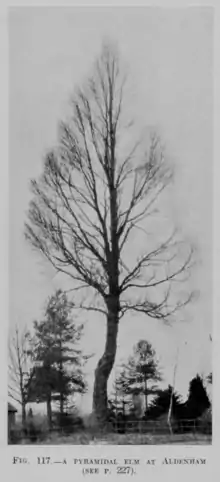| Ulmus minor 'Atinia Pyramidalis' | |
|---|---|
 'Atinia Pyramidalis', Aldenham, c.1922 | |
| Species | Ulmus minor |
| Cultivar | 'Atinia Pyramidalis' |
| Origin | UK |
The Field Elm cultivar Ulmus minor 'Atinia Pyramidalis', was first described as U. campestris pyramidalis by Vicary Gibbs[1] in the Gardeners' Chronicle (1922).[2] 'Pyramidalis' reportedly originated from a bud sport of "common elm" (English Elm) at Gibbs' Aldenham estate, Hertfordshire, England, c. 1890.[3]
Not to be confused with the cultivar known as pyramidalm 'pyramid elm' in Scandinavia, which is trimmed Exeter Elm.
Description
As implied by the epithet, the cultivar was pyramidal in shape. Gibbs described the Aldenham specimen as 85 to 90 ft. tall by 1922.
Pests and diseases
See under English Elm.
Cultivation
The extent of cultivation is unknown. No specimens are known to survive.
References
- ↑ kiki.huh.harvard.edu
- ↑ Gibbs, Vicary (1922). "Ulmus campestris pyramidalis". The Gardeners' Chronicle. 3. 71: 226 (fig 117), 227. Retrieved 16 June 2016.
- ↑ Green, Peter Shaw (1964). "Registration of cultivar names in Ulmus". Arnoldia. Arnold Arboretum, Harvard University. 24 (6–8): 41–80. Retrieved 16 February 2017.
This article is issued from Wikipedia. The text is licensed under Creative Commons - Attribution - Sharealike. Additional terms may apply for the media files.